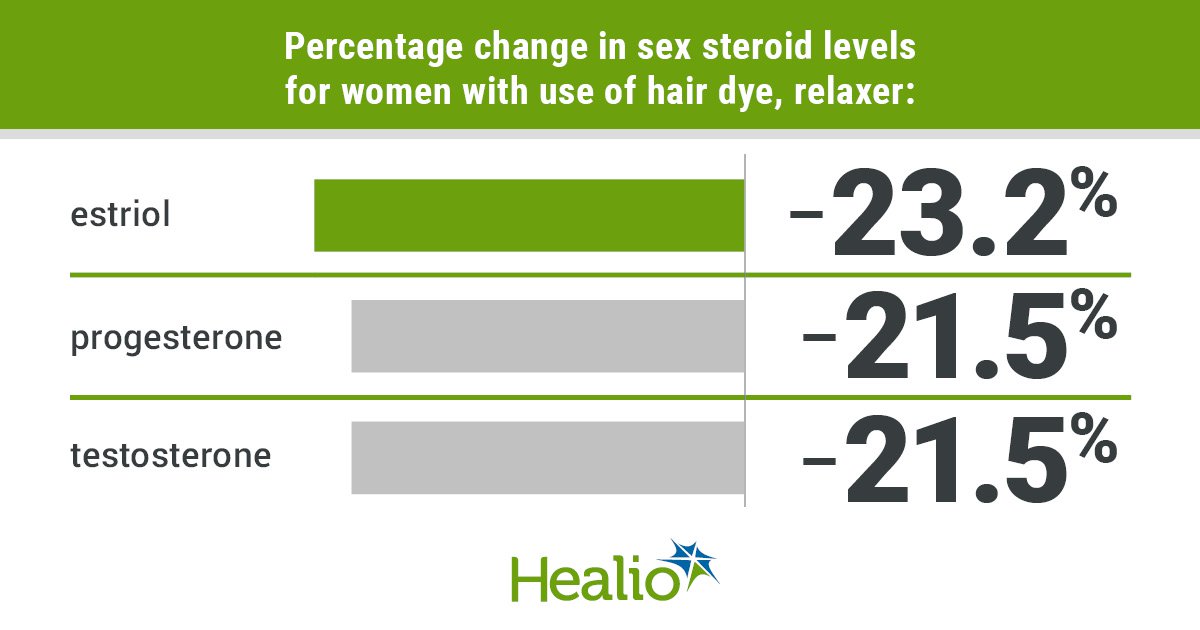December 28, 2021
2 minutes to read

Source / Disclosures
Published by:

Disclosures: The authors do not report any relevant financial disclosures.
The use of certain hair care products has been linked to lower levels of sex steroids in pregnant women, possibly due to the presence of endocrine disrupting chemicals, according to data published in Environmental research.

Zorimar Rivera –NOTUNthis
“Many chemicals found in personal care products, including phthalates, phenols and parabens, are known endocrine disruptors” Zorimar Rivera –NOTUNthis, PhD, MS, the assistant professor in the biostatistics and epidemiology department at the Rutgers School of Public Health in Piscataway, New Jersey, told Healio. “Women using hair care products, such as hair dyes, bleach, mousse and relaxers, had lower levels of sex steroid hormones than women not using these products. Sex steroid hormones are essential for fetal growth and maintenance of pregnancy. Sociodemographic factors, such as income and education, influence the frequency of use of personal care products.

Rivera-Núñez and colleagues analyzed data from 1,070 pregnant women enrolled in Puerto Rico PROTECT, an ongoing prospective birth cohort launched in 2010 to study environmental exposures in pregnant women and their children. The participants, who had not used oral contraceptives in the 3 months prior to pregnancy and had not used in vitro fertilization, underwent physical examinations and completed a series of questionnaires assessing self-reported product use. personal care products, including perfumes / colognes and soap, lotions, cosmetics, nail polish, shampoo and conditioner, shaving cream and mouthwash. Blood samples to measure the levels of nine hormones (corticotropin releasing hormone, sex hormone binding globulin, estriol, progesterone, testosterone, thyroid stimulating hormone, total triiodothyronine, total thyroxine and free thyroxine) were taken during the first visit (n = 910 samples) and third visit (n = 633 samples). The average age of women providing samples was 28; 80% have never smoked. The researchers used linear mixed models to examine associations between personal care product use and serum hormone levels.
The use of hair products, such as hair dyes and bleach, relaxers and foams, was associated with lower levels of all sex steroid hormones compared to non-use, including SHBG ( percent change, -7.1; 95% CI, -12.4 to -1.8), estriol (percent change, –23.2; 95% CI, –32.2 to –13), progesterone (percent change, –21.5; 95% CI, –29.4 to –12.9) and testosterone (percent change, –21.5; 95% CI, –33.1 to –7 , 8). The results persisted after adjusting for maternal age, education, and pre-pregnancy BMI.
“Our results suggest that household income and education level influence the use of personal care products among pregnant women in this study,” Rivera-Núñez told Healio. “The use of certain hair products was associated with lower concentrations of sex steroid hormones. Although there are limitations to the questionnaire data, characterization of personal care product use is inexpensive and may represent exposure to several classes of chemicals, including chemicals that may not specifically appear on product labels and / or have not been tested for their endocrine disrupting potential, making them a useful addition to chemical biomarker data.
Rivera-Núñez said that alterations in hormone levels, especially during pregnancy, can have consequences beyond birth health, including changes in infant and child growth and childbirth. puberty trajectories, and may influence the development of hormone-sensitive cancers, such as breast, uterine and ovarian cancer. .
“Primary care physicians and obstetricians should educate and counsel women of childbearing age about the potential health impact of endocrine disrupting chemicals such as those found in hair care products,” she said. . “We should replicate this study in other populations. There is a strong influence of beauty culture among Latin women, but also other populations, including black women. This will help us identify populations at risk. Second, refining tools such as frequency of use questionnaires to include brands and more time points will also help to better assess exposure, and reviewing multiple personal care products at the same time will help. to assess the impact of multiple exposures.
For more information:
Zorimar Rivera –NOTUNthis, PhD, MS, can be contacted at zr69@eohsi.rutgers.edu.
